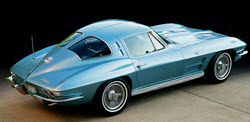1980 Corvette Sting Ray

One of the big buzzes regarding the 1980 Corvette Sting Ray was that the standard model failed to live up to California environmental laws. The standard 1980 Corvette Sting Ray had a 350 cubic inch engine capable of 190 hp. Since the Corvette developers had failed to find a technical solution that would make it live up to the strict California requirements, California residents had to settle for a 305 cubic inch engine capable of no more than180 hp. In compensation for this lower performance, they would receive a $50 credit from Chrysler. The California Emission Certification would on the other hand cost a whopping $250. There was also the issue with manual vs. automatic transmissions. When other buyers could choose freely between manual and automatic transmission (free of charge, both alternatives were available for the base 1980 Corvette Sting Ray), California residents had to pick the automatic transmission.
Why was the automatic transmission mandatory for California residents? There was never any law against manual four speed transmission in California, but it was much easier for a 1980 Corvette Sting Ray with automatic transmission to pass the California emissions certification. This has to do with how manual and automatic transmissions work. When you push the clutch on a manual transmission, you create a blip in the pollution output. When you use automatic transmission, the amount of pollution will be much more evenly distributed since automatic transmissions use torque converters instead of clutches.
The total production of 1980 Corvette Sting Ray cars landed on 40,614. As usual during this era, none of them were cabriolets. The original price for a base 1980 Corvette Sting Ray with a 350 cu. in. 190 hp engine was $13,140, but the price increased several times during the year before it finally ended up on $14,345. Air conditioning, power windows and a tilt/telescope steering column was all part of the base 1980 Corvette Sting Ray. For those who wanted a more powerful engine, and lived outside California, there was the L82 350 cu. in. 230hp engine. This option cost $595, sold to slightly over 12 percent of the buyers and was installed in roughly 5,000 1980 Corvette Sting Ray cars.
Among the new features in the 1980 Corvette Sting Ray was the seats. The 1978 Indy 500 replica seats that became standard in the 1979 model were now available in cloth. When you purchased your 1980 Corvette Sting Ray, you could choose between cloth and leather and none of alternatives came with a price tag. Both cloth and leather have their advantages. Leather gives off a luxurious air and is easy to keep clean, while cloth provides a higher amount of air circulation and feels less sticky in warm climates.
Another similarity between the 1978 Indy 500 replica and the 1980 Corvette Sting Ray was the bumper caps with integral spoilers. The 1980 spoilers were however slightly different, since they were seamless, hence more stylish. Another notable difference in the 1980 Corvette Sting Ray was the improved radiator airflow. The 1980 Corvette Sting Ray was also a low weight car compared to its predecessors. During the 1970’s, the Corvettes had grown heavier and heavier. The 1980 Corvette Sting Ray put a halt to this development by introducing a thinner hood, windshield, frame and door panels. The weight of the roof panels was also decreased and the designers used an an aluminum differential housing and crossmember.



